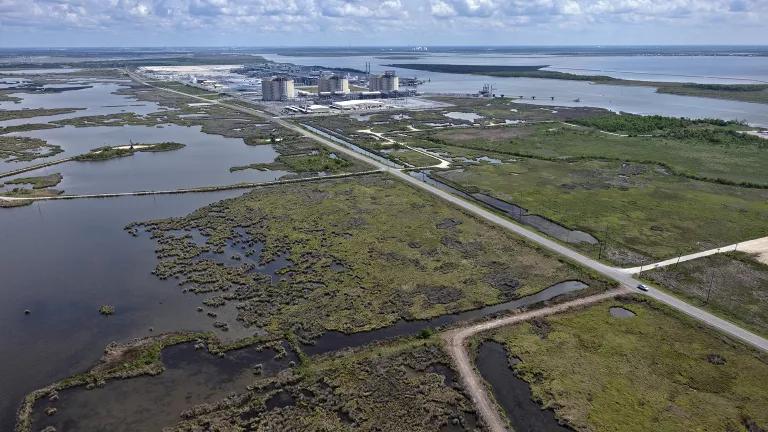DOE Shrugs as U.S. Natural Gas Exports Surge
A decade-long expansion of U.S. liquefied natural gas export terminals has transformed American energy policy.

Wetlands near the Cameron liquefied natural gas export terminal along the Calcasieu Channel in Hackberry, Louisiana
Julie Dermansky for NRDC
This blog was co-authored by Joshua Briggs, a 2023 summer intern with the Sustainable FERC Project.
A decade-long expansion of U.S. liquefied natural gas (LNG) export terminals has transformed American energy policy, altered the domestic and international gas market, and raised serious questions for climate health and communities. Yet when the U.S. government weighs these critical infrastructure projects, it does so without clear, comprehensive guidelines to determine whether expanding LNG is in fact in the public interest.
According to the U.S. Department of Energy (DOE), that’s just fine.
Last month, the DOE denied a request to establish comprehensive guidelines for LNG exports, a move that would better ensure that DOE is consistently and sufficiently vetting these exports. In its denial, DOE acknowledged the need for continued development of export policy, but nonetheless refused the request, further green lighting unchecked fossil fuel expansion.
The need for a revised approach is long overdue. DOE currently oversees LNG export applications based on LNG import guidelines established in 1984, during the Reagan administration, decades before the first U.S. LNG export terminal was built.
Ten years ago, at the cusp of the fracking boom, environmental groups first petitioned DOE to finally formulate guidance directed toward LNG exports. Inconceivable in the 1980s, fracking opened up the prospect for U.S. gas producers to sell gas overseas. That became a reality in 2016 when the U.S. began exporting LNG from the lower 48 states.
Thanks to new, DOE-sanctioned exports, and LNG terminals greenlit by the Federal Energy Regulatory Commission (FERC), in 2022, the U.S. became the world’s largest exporter of gas (surpassing Russia, which cut shipments to Europe following the war in Ukraine). U.S. exports averaged 10.6 billion cubic feet per day (Bcf/d) in 2022, a nine percent increase over 2021.
To date, DOE has yet to deny a proposed LNG export, despite a growing recognition across the federal government of the scientific reality of climate change and the pressing need for federal agencies to focus on environmental justice and equity. LNG export terminals are often located near lower-income communities that have disproportionately suffered from the negative impacts of energy development.
In October, we joined an effort to persuade DOE to finally answer the 2013 petition and expand its analysis of LNG exports. In its July 18 decision denying the request, DOE said that weighing the merits of LNG projects individually “reasonably satisfies” the concerns raised by NRDC and others and that “under most circumstances, the market is the most efficient means of allocating natural gas supplies.”
We remain unconvinced.
DOE needs updated policy designed for LNG exports, and the public deserves a meaningful chance to weigh in—especially low-income communities and communities of color, who face most of the first and worst harms of LNG exports. Unfettered approval of LNG exports harms public health, the climate, and environmental justice communities.
Nonetheless, in denying sensible requests for updated policy, the Biden administration has doubled down on allowing near-quadragenarian LNG import policy guidelines to continue to serve as the regulatory roadmap when DOE reviews gas exports. It’s high time to bring LNG policies into the 21st century.
Sadly, DOE is not the only federal agency faltering on the LNG test. In 2021, the D.C. Circuit ruled that FERC's evaluation of the environmental justice effects of a LNG export terminal in Texas was arbitrary, capricious, and unexplained.
FERC has attempted to make some changes. In 2021, it reversed a decision that excluded from consideration almost all upstream and downstream greenhouse gas emissions associated with a pipeline project. Later, FERC hired its first ever Senior Council for Environmental Justice, as then-FERC Chairman Rich Glick vowed to prioritize environmental justice reviews. In 2022, FERC issued new gas policy statements, promising to end the era of rubber-stamp pipeline approvals and incomplete GHG reviews. But after vigorous pushback from fossil interests, FERC reverted both policies to “draft” status, even as the need for them becomes clearer every day.
Both FERC and DOE must redouble efforts to overhaul outdated and incomplete frameworks for reviewing gas projects. It’s long past time to fully evaluate the public interest before approving new gas pipelines or liquefied natural export facilities. Not only does it follow common sense, but the law demands it. This begins with clear and sensible guidelines.




